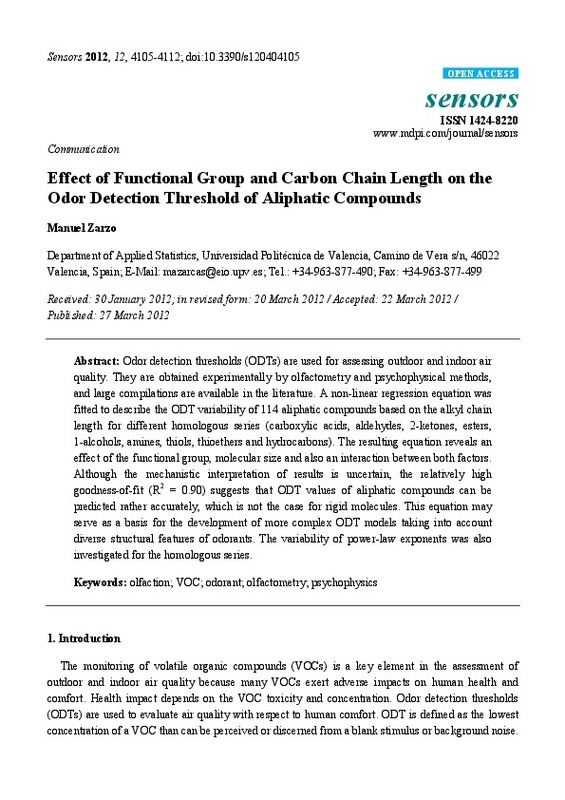Kim, K.-H. (2010). Experimental Demonstration of Masking Phenomena between Competing Odorants via an Air Dilution Sensory Test. Sensors, 10(8), 7287-7302. doi:10.3390/s100807287
Kim, K.-H. (2011). The Averaging Effect of Odorant Mixing as Determined by Air Dilution Sensory Tests: A Case Study on Reduced Sulfur Compounds. Sensors, 11(2), 1405-1417. doi:10.3390/s110201405
Laing, D. G., Panhuber, H., & Slotnick, B. M. (1989). Odor masking in the rat. Physiology & Behavior, 45(4), 689-694. doi:10.1016/0031-9384(89)90280-1
[+]
Kim, K.-H. (2010). Experimental Demonstration of Masking Phenomena between Competing Odorants via an Air Dilution Sensory Test. Sensors, 10(8), 7287-7302. doi:10.3390/s100807287
Kim, K.-H. (2011). The Averaging Effect of Odorant Mixing as Determined by Air Dilution Sensory Tests: A Case Study on Reduced Sulfur Compounds. Sensors, 11(2), 1405-1417. doi:10.3390/s110201405
Laing, D. G., Panhuber, H., & Slotnick, B. M. (1989). Odor masking in the rat. Physiology & Behavior, 45(4), 689-694. doi:10.1016/0031-9384(89)90280-1
Cometto-Muñiz, J. E., Cain, W. S., & Abraham, M. H. (2003). Dose-addition of individual odorants in the odor detection of binary mixtures. Behavioural Brain Research, 138(1), 95-105. doi:10.1016/s0166-4328(02)00234-6
Laska, M., & Hudson, R. (1991). A comparison of the detection thresholds of odour mixtures and their components. Chemical Senses, 16(6), 651-662. doi:10.1093/chemse/16.6.651
Miyazawa, T., Gallagher, M., Preti, G., & Wise, P. M. (2008). Synergistic Mixture Interactions in Detection of Perithreshold Odors by Humans. Chemical Senses, 33(4), 363-369. doi:10.1093/chemse/bjn004
Laffort, P., Etcheto, M., Patte, F., & Marfaing, P. (1989). Implications of power law exponent in synergy and inhibition of olfactory mixtures. Chemical Senses, 14(1), 11-23. doi:10.1093/chemse/14.1.11
Hellman, T. M., & Small, F. H. (1974). Characterization of the Odor Properties of 101 Petrochemicals Using Sensory Methods. Journal of the Air Pollution Control Association, 24(10), 979-982. doi:10.1080/00022470.1974.10470005
Kim, K.-H., & Park, S.-Y. (2008). A comparative analysis of malodor samples between direct (olfactometry) and indirect (instrumental) methods. Atmospheric Environment, 42(20), 5061-5070. doi:10.1016/j.atmosenv.2008.02.017
Amoore, J. E., & Hautala, E. (1983). Odor as an ald to chemical safety: Odor thresholds compared with threshold limit values and volatilities for 214 industrial chemicals in air and water dilution. Journal of Applied Toxicology, 3(6), 272-290. doi:10.1002/jat.2550030603
Edwards, P. A., & Jurs, P. C. (1989). Correlation of odor intensities with structural properties of odorants. Chemical Senses, 14(2), 281-291. doi:10.1093/chemse/14.2.281
Abraham, M. H. (2002). A Model for Odour Thresholds. Chemical Senses, 27(2), 95-104. doi:10.1093/chemse/27.2.95
Zarzo, M. (2007). The sense of smell: molecular basis of odorant recognition. Biological Reviews, 82(3), 455-479. doi:10.1111/j.1469-185x.2007.00019.x
Ohloff, G., & Giersch, W. (1980). Stereochemistry-Activity Relationships in Olfaction. Odorants containing a proton donor/proton acceptor unit. Helvetica Chimica Acta, 63(1), 76-94. doi:10.1002/hlca.19800630109
Yoshii, F., Liu, Q., Hirono, S., & Moriguchi, I. (1991). Quantitative structure-activity relationships of structurally similar odorless and odoriferous benzenoid musks. Chemical Senses, 16(4), 319-328. doi:10.1093/chemse/16.4.319
Sell, C. (2004). Scent through the Looking Glass. Chemistry & Biodiversity, 1(12), 1899-1920. doi:10.1002/cbdv.200490146
Schnabel, K.-O., Belitz, H.-D., & Ranson, C. (1988). Untersuchungen zur Struktur-Aktivit�ts-Beziehung bei Geruchsstoffen 1. Mitteilung: Wahrnehmungsschwellenwerte und Geruchsqualit�ten von ges�ttigten aliphatischen und alicyclischen Verbindungen mit Sauerstoff-Funktion. Zeitschrift f�r Lebensmittel-Untersuchung und -Forschung, 187(3), 215-223. doi:10.1007/bf01043342
Walker, J. C. (2003). Human Odor Detectability: New Methodology Used to Determine Threshold and Variation. Chemical Senses, 28(9), 817-826. doi:10.1093/chemse/bjg075
Brower, K. R., & Schafer, R. (1975). The recognition of chemical types by odor. The effect of steric hindrance at the functional group. Journal of Chemical Education, 52(8), 538. doi:10.1021/ed052p538
Saito, H., Chi, Q., Zhuang, H., Matsunami, H., & Mainland, J. D. (2009). Odor Coding by a Mammalian Receptor Repertoire. Science Signaling, 2(60), ra9-ra9. doi:10.1126/scisignal.2000016
Wright, R. H. (1978). The perception of odor intensity: physics or psychophysics? Chemical Senses, 3(1), 73-79. doi:10.1093/chemse/3.1.73
Wright, R. H. (1978). The perception of odor intensity: physics or psychophysics II. Chemical Senses, 3(2), 241-245. doi:10.1093/chemse/3.2.241
Wright, R. H. (1982). Odour and molecular volume. Chemical Senses, 7(2), 211-213. doi:10.1093/chemse/7.2.211
Cain, W. S. (1971). Physicochemical characteristics and supraliminal odor intensity: Reply to Mitchell. Perception & Psychophysics, 9(6), 478-479. doi:10.3758/bf03208957
[-]









